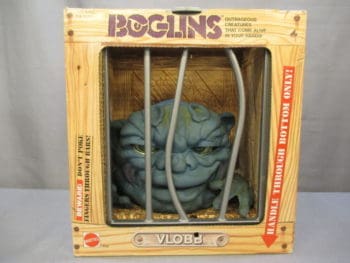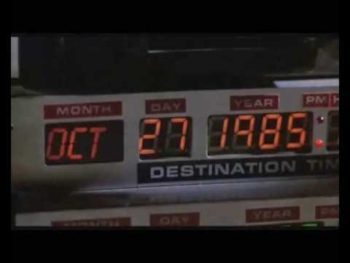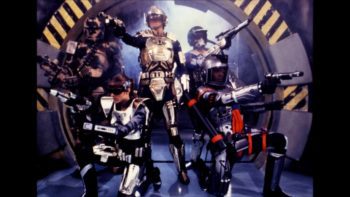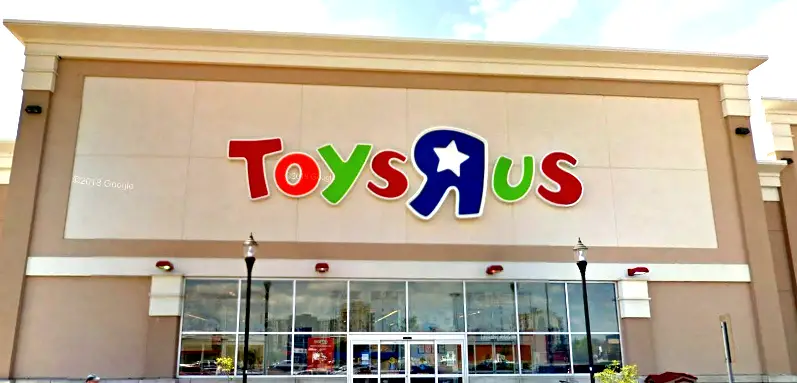
It was a seminal part of our childhood and stepping through its hallowed doors led us to a fantasy world of the greatest toys and products we dare not even dream about.
Toys “R” Us started in 1958 and became the defining toy store for decades. It helped boost the popularity of many toys from the 70s to the 90s, but the company would experience hard times and declare bankruptcy in 2017.
As a kid, I never got to go to Disneyland. Toys “R” Us was the closest I ever got. But to me, it seemed like there could be no bigger thrill. Just walking in there was a sensory overload. Getting to go to Toys “R” Us before birthdays, or during the Christmas season, was like the land of possibilities.
There were many toys I adoringly looked at that I knew I would never get, but even just the idea of getting them was a thrill. Just being in there and seeing some of these iconic toys in person was a thrill in itself.
But how did this iconic company go from a pivotal part of our childhoods to bankruptcy? Shouldn’t a toy store last forever? This is a look back at the rise and fall of the iconic Toys “R” Us.
The Origins of Toys “R” Us
Before researching this, I did not know that Toys “R” Us went back to the late 1940s. It all started with Charles P. Lazarus. Lazarus had started a baby furniture company in 1948. This was a smart business idea, as the post-war baby boom made for an endless amount of business.
The company was called Children’s Bargain Town. Besides the baby furniture, it was natural that they would sell a small line of baby and children’s toys. After a while, the toys started to be the better seller.
There were a few reasons for this: the first is that baby furniture is something you tend to only buy one of. You buy a high chair once, and that’s it. And this was the 1940s, so they made items a lot better than the crap we have today. The furniture was so solid that it seemed to last indefinitely. People just didn’t need to go back.
But they would go back for toys.
Toys are great. They are generally cheap, kids get bored with them and want something new, and they tend to break quicker, leading to repeat purchases. Lazarus was smart enough to see an excellent opportunity. He would go all-in on toys.
Exactly 10 years later, Lazarus would open a story that would forever change the lives of millions of kids.
The First Toys “R” Us
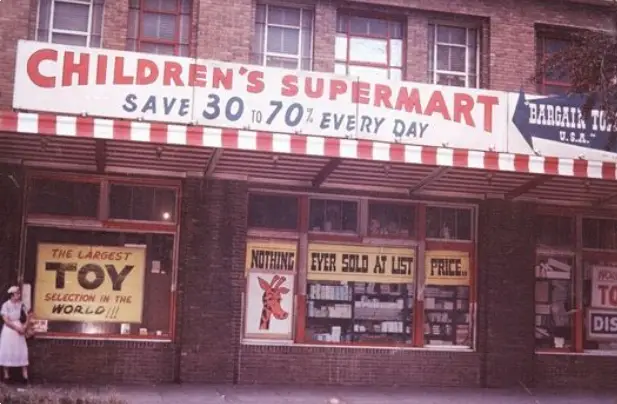
In 1958, the very first Toys “R” Us opened in Rockville, Maryland. But it was a bit of a weird name. It obviously has the word ‘toy’ in the title, so you can be pretty sure what they were selling, but why use the letter R instead of the word ‘are?’ And why make the R backwards? It also didn’t sound grammatically correct.
Well, all you have to do is look at the founder’s name: Lazarus… Laz “R” us.
As for the backward R; it was pretty simple, it was made to look like a child wrote it. Lazarus created and designed the iconic logo using a good mix of primary and bright colors. It really was a perfect logo to get the attention of kids.
Toys “R” Us came out pretty hot. In the 1960s and 70s, it quickly cemented itself as one of the dominant toy stores. To kids born during this time–and leading up to the 80s–it was the brand that children recognized.
Like any good product directed at kids, Toys “R” Us would need some sort of mascot. We already had Mickey Mouse, Ronald McDonald, Tony the Tiger, Cap’n Crunch, and various other mascots, but Toys “R” Us definitely needed to go the animal mascot route.
Animals are important for appealing to children. They call it anthropomorphism. This is when you give human-like characteristics to animals. Children are drawn to animals, and when you can create one with human-like features, it makes them more trusting and builds more brand identity and loyalty.
This is the reason pretty much every breakfast cereal uses one. (Read all about 1980s breakfast cereals in my article here.) Anthropomorphism was also one reason you saw the use of Joe Camel to sell cigarettes. They were trying to appeal to kids.
Basically, by using anthropomorphism, a brand is able to build trust and make its company more likable.
Enter Geoffrey the Giraffe.
Fun fact: At first, Geoffrey was going to go by Dr. G Raffe. This was in 1965 but he would become Geoffrey the Giraffe going into the later 1960s. He would be a key part of Toys “R” Us’ advertising and the way to build more of that trust with customers.
A live-action Geoffrey would be used in commercials starting as early as 1972. He was pretty big but could move around and even tap dance. You could argue that Toys “R” Us was replicating what they were seeing in Disneyland or even vice versa.
By 1981, Geoffrey the Giraffe would be mainly used in animated commercials–and there was an ulterior motive behind this. The early 80s was an interesting time, because of the deregulation of the restrictions on children’s advertising. Up to this point, there were severe regulations on how companies could market to kids. Young children could not differentiate between what was a cartoon and what was commercial.
(read all about deregulation and advertising to children, here)
When Ronald Reagan lifted all these regulations, companies had full rein on attacking kids through as much corrupt advertising as possible. This is when you saw the use of licensed characters go up by 300% and they turned commercials into straight cartoons. Kids were now being bombarded by marketing that manipulated their senses and understanding. Toys “R” Us got right on board with this.
In 1983, to further confuse things, Thurl Ravenscroft performed the voice of Geoffrey. You might not know that name, but you definitely know his voice. Ravenscroft was the voice of iconic cartoon characters such as Tony the Tiger and sang “You’re a Mean One, Mr. Grinch” from How the Grinch Stole Christmas.
Good luck, kids!
The Importance of Toys “R” Us and Popular Culture in the 1980s
If it wasn’t for Toys “R” Us, some of the most popular toy crazes of the 80s might not have ever happened. Since Toys “R” Us’ was everywhere, new products were more accessible. It’s not that big new toy brands wouldn’t have been successful, but if they were only available in a Sears or Kmart, they might not have created as big a splash.
Also, when you went to somewhere like a Kmart, it was when your parents needed a ton of other stuff. Toys were just a small part of those stores. But not at Toys “R” Us; this was 100% toys only.
Some of the obvious toy crazes that benefited from this unique toy-only store include G.I. Joe, Rainbow Brite, Transformers, Teddy Ruxpin, Teenage Mutant Ninja Turtles, Furby, Pogs, Pound Puppies, and He-Man, just to name a few. When these toys entered our lives, we wanted them more than life itself. And there was no debating where you needed to go to find them: Toys “R” Us.
Any toy worth its salt could be found at Toys “R” Us–especially ones being heavily promoted through commercials and new cartoon series. I couldn’t guarantee that a G.I. Joe Hovercraft would be at my local Zellers, but I knew damn sure I could find it at Toys “R” Us.
Not only could you find specific toys there, but you could also find a lot of them. This made it more likely you could get one–or at least have a better chance of getting one. After all, “it’s the biggest toy store there is…”
Toys “R” Us may have been instrumental in the Cabbage Patch Kids craze of 1982 (read all about that in my blog here). The hype for these things was off the chart and parents made a beeline for the nearest Toys “R” Us. But these dolls were flying off the shelves, and since Toys “R” us could carry more stock, the fact they didn’t have any meant this thing was a legitimate craze.
People were driving to other states to try and find them. Smaller stores may have only been able to carry a handful, but since Toys “R” Us could purchase larger quantities, going there was your best bet to try and find one. This would lead to more news reports and stories of mob mentality taking over in the stores.
If Toys “R” Us didn’t exist, the Cabbage Patch Kids craze might not have happened. There would have been nowhere that could carry such a vast supply and the best chance to get one.
Toys “R” Us might also be responsible for the success of the original NES. As video games made a comeback in 1985/86, Toys “R” Us would be their unofficial home. Video games had moved from “computer games” to entertainment systems. No other store would be able to perfectly display them, have the room to do so, and provide demonstration units to show how great they were. I really feel that when Nintendo launched new games, systems, and anything to do with Mario, they had Toys “R” Us in mind to make the launch successful.
A hot toy craze can only go as far as the commercial hype: it eventually needs to get in stores, be properly displayed, and be available. It’s easy to overlook their role in these huge franchises, but Toys “R” Us may have been the major player in a lot of our popular culture.
Things Are Not as Great as They Seem
You’re probably thinking about how Amazon and online shopping led to the downfall of Toys “R” Us, but we’re not quite there yet.
Things were humming along and in 1978, Toys “R” went public. Five years later, they expanded with Kids “R” Us. I don’t think I ever went into one of these? But it was a clothing store for kids. In 1996, they expanded even further to Babies “R” Us.
But by 2005, things looked a little shaky. That year, Toys “R” Us was taken off the stock market. Apparently, they were bought and turned into a private company during a leveraged buyout. The average kid would not understand what was going on behind the scenes, but little did we know the company was heading for a shock bankruptcy.
In 2017, the toy giant had somehow gone bankrupt. What the hell happened? How could the definitive toy store–and instantly recognizable brand–get to this point? Similar to Kmart, the company had been racking up debt.
(read about a similar story aka the rise and fall of Kmart, here)
A lot of the debt seemed to occur in 2005. That was the year the company was purchased in that leveraged buyout. The big issue is they essentially bought the company with debt. With a leveraged buyout, huge loans were taken out, so ownership had started in the red. This was a massive risk, but the thought was the world’s biggest toy store would eventually make back this money.
But between 2005 and 2017, a lot of other changes happened. Competition from Walmart and Target was one of the biggest things. The company was also now privately owned.
Toys “R” Us also went full-on with the holiday season. This time of year is obviously their bread and butter and up to 40% of the year’s profits are made at Christmas. The company started doing things like keeping stores open for 24 hours. In 2013, they decided stores would stay open for 87 straight hours leading up to Christmas.
But keep in mind: Toys “R” Us had been around for nearly 60 years. Again, like Kmart, this was affecting operation. Decades-old systems needed updating. A better online presence was also needed. Customer service, store layouts, and better pricing strategies and promotions really needed to be improved.
I Don’t Wanna go Bankrupt, I’m a Toys “R” Us Kid
I don’t totally understand these leveraged buyouts, but they really put a company behind the 8-ball. The interest rates are so high that it can be hard for the company to keep its head above water. If this buyout happened in, say, 1985, it probably wouldn’t be an issue because Toys “R” Us ruled the landscape. In the 2000s, that landscape had drastically changed.
This debt was going to be brutal.
The timing of this seems to be pretty bad, especially with the online shopping world-changing. I think Toys “R” Us thought this wouldn’t hurt them because they had a big online store. They actually had been kind of early to the internet game and had launched Toysrus.com nearly 20 years prior. They had also bought etoys.com and toys.com to have a wide online base.
But it was hard to predict how big the online shopping space would become–and how big Amazon would grow. Remember, going into the 2000s, Amazon had been primarily just selling books.
But here’s something really interesting. In 2000, Toys “R” Us actually entered a ten-year agreement with Amazon. The online giant was nowhere as big as it is now, so back then, Toys “R” Us would be an exclusive supplier of toys and baby products.
The deal was worth $50 million, but Toys “R” Us would sue Amazon in 2004 because the perceived lack of variety in toys allowed third-party sellers to come in. These third parties were now selling toys competing directly with Toys “R” Us on products the toy company believed they had the exclusive rights to sell.
This would drag on for six years until Toys “R” Us was allowed to get out of the agreement and also awarded $51 million. It’s an interesting situation of worlds colliding. It would be interesting what the trajectory of Toys “R” Us would have been had this original deal with Amazon worked.
But eventually, Walmart and Target would start to offer all the same toys, but for a lot cheaper. Plus, Walmart and Target had everything else you needed on a shopping trip, so you could get everything under one roof.
Hanging on For Dear Life
In 2017, Toys “R” Us declared chapter 11 bankruptcy. This doesn’t mean they went under, but could restructure. They had nearly $5 billion in debt and had to borrow another $2 billion to get through that year’s holiday season.
In 2018, they announced they would liquidate and close 182 stores. They would combine some stores with Babies “R” Us.
Here in Canada, the company was actually going along pretty decently. We heard all about the shock closing of all the American stores, but it seemed like our Canadian locations might stay put.
Even being older, it was a real dagger to hear Toys “R” Us was falling apart. They soon announced that all U.S. stores would be closed. The 82 stores we still had in Canada were actually profitable and different companies were interested in acquiring them. The brand was obviously still recognizable.
But on June 29, 2018, all U.S. stores were closed. A huge part of everyone’s childhood shut its doors for the last time. In a pretty heartwarming move, some unknown organizations bought out the remaining stock so the toys could be donated to charity. A pretty classy move, if you ask me.
But a few stores hung on. The company came out of bankruptcy in 2019 and emerged as Tru Kids. They even opened two new Toys “R” Us locations. Unfortunately, both would close in January 2021.
But the Toys “R” Us name has not completely disappeared—nor do I ever think it will. It’s just too recognizable and may always exist in some format. The website continues to live on, and in December 2021, the company opened a giant, two-story flagship store in New Jersey.
So What Led to the Downfall of Toys “R” Us?
I’ve heard a few arguments about how kids don’t play with toys the same way we did in the 70s and 80s. I’m not sure if this is totally true, but modern kids might not have had the wide range of amazing toy franchises we did back then.
There will always be a hot new toy of the season, but in the 80s, we had several every year. And they lasted for most of the decade. With no advertising restrictions, it was the wild west of toys and how they could market them. Going into the 90s and 2000s, those restrictions started to come back. Did that have a major impact on kids wanting a toy more than life itself?
But back in the 80s–and the decades leading up to it–we just didn’t have as many entertainment options. Yes, we had TV and video games, but not at the level available now.
Kids will always play with toys, but have they gravitated even more so to video games? And most video games don’t even exist in a physical format. You buy or stream them online, so there’s really no reason to go to a brick-and-mortar store.
And with the upgrades and add-ons available for each game, you can keep playing the same game for a few years. Modern games constantly change and evolve and these games continue to feel like they’re new. When we had Duck Hunt, that was it. It never changed.
My nieces and nephews loved toys when they were little, but as they got older, they were much more likely to spend time on a tablet or on video games. Did toys reach their peak in the 1980s? Is the idea of a physical toy store completely outdated?
There are a lot of factors that lead to the demise of Toys “R” Us and it’s impossible to pinpoint its fall to just one thing. I’m going to come out and say it: toys reached their peak in the 1980s. And Toys “R” Us was the magical gateway to them.
Speaking of sweet toys, make sure to check out my Resources page which has links to some epic 80s-related products you can find on Amazon.

